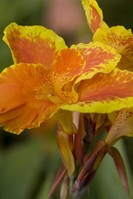

With warmer weather approaching and more sunshine on deck, it’s the perfect time to be outside in St. Johns County. Lawn and home improvement stores are slammed on the weekends in Northeast Florida as residents scramble to get the latest gadgets, the best nursery plants and everything else they need to start dressing up outdoor spaces.
If you have a garden or are interested in starting one, you may feel intimidated walking down the aisles of plant nurseries. Sure – the flowers, shrubs, trees and vegetables are thriving there. But will they work in your garden? And when you should plant them?
Luckily, it doesn’t take a green thumb to keep your garden and lawn healthy all year long.
There is plenty of advice to be had online, but one of the very best sources for our area comes from the University of Florida, which provides a free yearly calendar about what to plant when, along with advice on what to do for your existing plantings each month: http://edis.ifas.ufl.edu/ep451
Here is their advice for March and April, so you can get a head start on planting!
March
Annuals/Bedding Plants: In March, Dianthus and other cool-season annuals will continue to flourish. Consider planting warm-season annuals such as angelonia, wax begonia and zinnia at the end of the month.
Bulbs: Plant dahlia, canna and gloriosa bulbs in March for spring and summer flowering. Provide stakes as needed to support growth.
Herbs: March is the time to plant and grow edible ginger. Plant rhizomes in well-drained soil in full to part sun.
Vegetables: Begin planting warm-season crops, such as beans, tomatoes, squash and corn, early in March for a late spring harvest. On the off chance that we receive frosty weather again, be sure to protect these crops.
Azaleas: Prune your azaleas when they have finished blooming to reduce their size and improve their form.
Shrubs and trees: Wait to prune until you see new growth on your shrubs and trees.
Palms and shrubs: Fertilize palms, azaleas, camellias and other ornamental shrubs if needed in March. Choose a fertilizer in which at least 30% of its nitrogen is slow release.
Irrigation: Now is the time to check your sprinkler system for problems such as broken or misaligned spray heads.
April
Annuals/Bedding Plants: New varieties of coleus do well in sun or shade and provide vivid colors and patterns for months. Plant them in early April.
Bulbs: April is an ideal time to plant many bulbs. Consider blood lily, caladium or canna. Louisiana iris and others make beautiful cut flowers.
Herbs: Plant heat-loving herbs, including basil, oregano, sage, Mexican tarragon and rosemary, in April.
Vegetables: Continue planting warm-season crops. Mulch well to prevent weeds and provide irrigation if rainfall is lacking.
Pests: April is the time to start monitoring landscape plants for aphids that feed on tender new growth.
Beneficials: Identify and conserve beneficial insects. These insects should be encouraged in your yard!
Perennials and bulbs: Divide clumps of bulbs, ornamental grasses or herbaceous perennials to expand or rejuvenate garden beds or to pass along to friends.
Lawn insects: If you’re experiencing lawn woes, be sure to rule out cultural problems, such as lack of water, that resemble insect damage before applying a pesticide.
Lawns: Apply fertilizer after new growth has started—usually mid-April for north Florida.
Shrubs: Choose from a wide variety of shrubs to add to the landscape in April.
Trees: Consider planting a spring-blooming tree, such as fringetree (Chionanthus virginicus), Carolina Silverbell (Halesia carolina) or redbud (Cercis canadensis).
Mulch: Add mulch to minimize weeds and conserve moisture during dry weather, starting in April. Organic mulches break down and add nutrients to the soil.